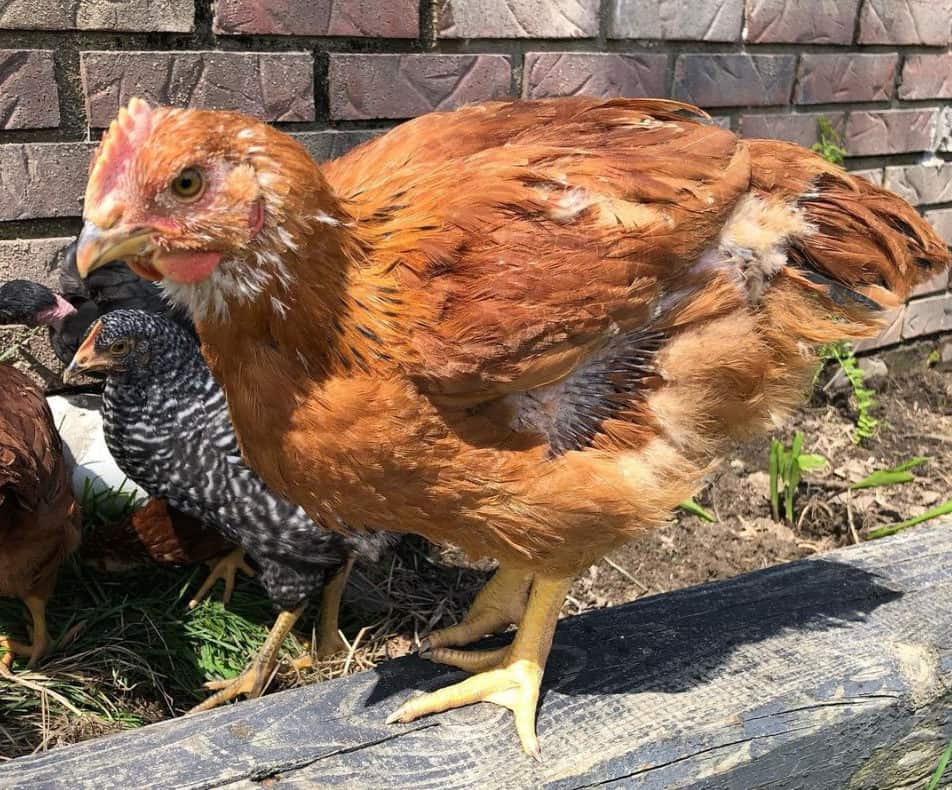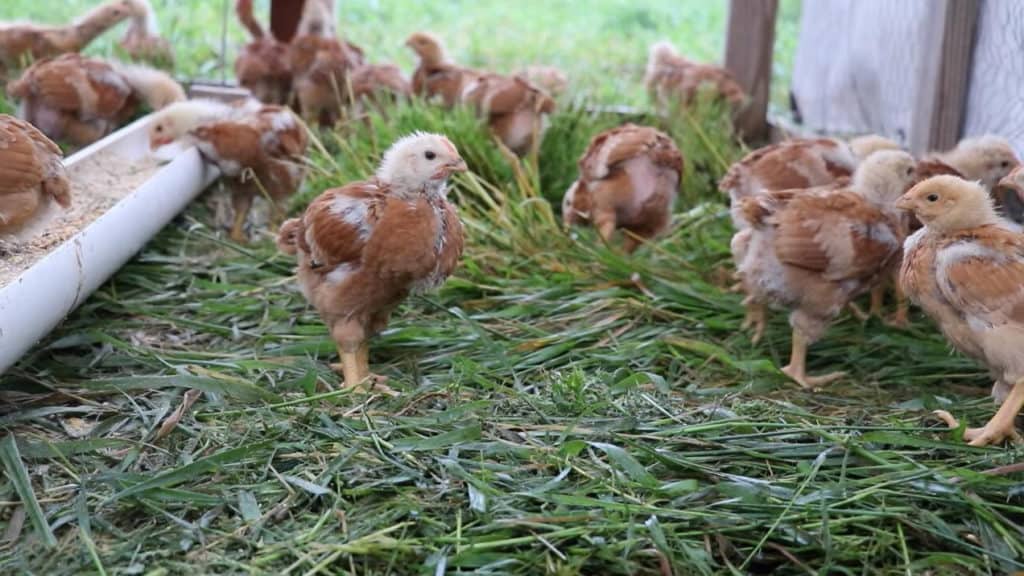If you’re looking for a chicken that can lay eggs and be a good source of meat, then you should consider raising Red Rangers. These chickens are a hybrid developed to live healthier, longer lives than fast-growing meat birds while still growing and laying at an impressive rate.
This article will cover
- History of Red Ranger Chickens
- Breed Standard and Appearance
- Personality and Temperament
- Red Ranger Chicken Egg Laying
- Health Issues and Care
- 3 Tips for Raising Red Rangers
History of Red Ranger Chickens

The Red Ranger is technically not a breed of chicken, but instead, is a hybrid created to fill a specific niche. Most dual-purpose breeds take around 6 months to grow to a size that is right for butchering.
This was longer than many people wanted to wait, but the alternative – mainly Cornish Chicken Crosses – grow so fast that they often have health issues such as weak hearts and legs, and they don’t produce eggs.
This didn’t always sit well with organic, sustainable farmers who wanted a heartier breed of chicken that could live a more natural life while still providing eggs and meat in a decent time frame. Big corporations such as Perdue Farms – the fourth-largest producer of poultry in North America – were also looking for an alternative to the fast-growing meat chickens.
This was due to rising concerns about the number of antibiotics needed to keep these birds healthy and the conditions many of them are kept in due to their propensity for weak legs and heart attacks if they moved too much. This is when the Red Ranger was developed.
These red chickens grow faster than other dual-purpose breeds and are ready to be butchered at around 12 – 14 weeks. While they were developed to be better meat producers than egg layers, they are still a good source of eggs. They start laying at 16 weeks and can lay around 175 eggs a year.
Since the Red Ranger is not an officially recognized breed, there isn’t a lot of information available about the bloodlines and lineage that went into the development of these birds.
It is generally assumed, though, that they are the product of cross-breeding excellent layers like Rhode Island Reds and New Hampshires with the best meat birds like Cornish Crosses and Delawares.
Red Ranger Chicken Overview
| Feature | Red Ranger Chicken |
|---|---|
| Purpose | Dual-purpose |
| Egg Color | Light-brown |
| Egg Size | Medium to Large |
| Broody | No |
| Heat Tolerance | Yes |
| Cold Tolerance | Yes |
| Comb Type | Red comb |
| Egg Production | Around 175 eggs per year |
| Chicken Skin Color | Yellow |
| Life Span | Up to 2 years |
| Adult Weight | Hen: ~5 lbs, Rooster: ~6 lbs |
| Backyard Friendly | 4/5 |
Breed Standard and Appearance

As previously mentioned, the Red Ranger isn’t an officially licensed or recognized breed, which means there is no industry standard when it comes to the appearance or composition of birds that fall into this category. They are actually often confused with other broiler birds such as the Freedom Ranger and Dixie Ranger.
Red Rangers, though, can be identified by the copper-red and honey-brown color of their plumage and the shape of their bodies. Red Rangers are around the same size as most broiler breeds, with the males weighing around 6 pounds when they’re 10 weeks old and females weighing around 5 pounds at 10 weeks.
Their bodies are a solid rectangular shape, and they have strong, thick yellow legs and feet. They have the same slender profile in the chest that Rhode Island Reds do, though Red Rangers have lighter colored plumage compared to the deep mahogany of the Rhode Island Reds.
The slender chest means Red Rangers have less breast meat than the broader-chested White Broilers and Cornish Crosses. Red Rangers are sturdy birds and have black highlights on their wings and tails and have red combs and wattles.
Personality and Temperament
Part of the appeal of Red Rangers is their independence and more “chicken-like” natures. These birds are excellent foragers and are happiest when they are raised free-range or allowed to roam pastures or larger fields. They are very active and energetic birds, and will not be content being kept in small pens like a Cornish Cross or White Broiler might be.
Their deep coloring provides some camouflage when they are out roaming, and they do have some basic survival instincts not usually seen in other broiler birds.
This independence and desire to forage for their own food means they are easier to care for than other broilers, and you don’t have to spend as much money on feed as long as they are allowed to roam a sufficiently large patch of land.
Red Rangers usually aren’t more aggressive than your average farm chicken, though temperaments vary. They should be raised in small flocks and can be raised with other standard breeds as well. They don’t often get broody, and they make good chicken tractor birds as long as you move it daily so they have access to fresh grass and plenty of opportunities to find food.
Red Ranger Chicken Egg Laying

When the Red Ranger hybrid was developed, there was more emphasis placed on developing them as meat birds instead of maximizing their egg-laying capabilities.
This means that if you are looking for chickens to primarily provide eggs, or to provide a lot of eggs before being turned into dinner, you might want to look into a hybrid like the Golden Comet which can produce between 250 – 320 eggs a year.
However, as far as dual-purpose birds go, the Red Ranger still supplies a decent number of eggs, averaging around 175 eggs a year.
Their eggs are usually medium to large sized and light-brown in color though, of course, size and frequency will vary depending on individual chickens and whether or not they have access to enough feed. If you want your Red Rangers to lay well, you should be sure to provide a supplemental feed that is high in protein.
They start laying eggs at 16 weeks, and since they are sturdier, slower-growing birds, you have a longer window to let them lay eggs before they reach the higher end of a desirable butchering weight if you plan on using them like true dual-purpose birds.
Health Issues and Care

Since Red Rangers are hybrids, they don’t have the health issues that many other broiler birds have. Unlike the Cornish Cross which grows too quickly for its legs and organs to keep up, the Red Rangers have a slower growth rate which allows for normal, healthy development.
This means they don’t have the weak legs and hearts that a Cornish Cross will have, and they can live much longer without significant health issues. Red Rangers have been known to live up to two years when properly cared for.
Red Rangers also have a better survival rate since they are more able to fend for themselves, retain some basic survival instincts, and are more physically capable than other fast-growing meat chickens tend to be. There is a potential downside to these hybrids, though. Since they are not a true breed, they can’t breed true with each other.
This means that if you were hoping to keep a rooster around and breed these chickens to sell or replenish their flock numbers naturally as needed, this isn’t an option. This is true for most hybrids and fast-growing meat chickens.
3 Tips for Raising Red Rangers

1. Find the Right Feed
These chickens are free-ranging, but should still be supplied with supplemental feed. When they’re first born, feed them chick starter for the first 16 weeks until they reach maturity. Then, you should supplement their natural foraging with a 20% protein feed. You can also give them treats to vary their diet such as:
2. Monitor Roaming
While these birds are happiest when they can forage food for themselves, the downside to free-range birds is that they take longer to grow to butcher size. This is because calories are burned in the process of digging and moving around to find food, so the more roaming your Red Rangers do, the slimmer they will stay.
If you plan on keeping them long-term or don’t have a butcher deadline, allow them to roam as they wish. If, however, you need them to plump up faster or want them to get as big as possible for higher meat yield, try limiting the space they have to roam in and the amount of time you leave them to wander.
You can also feed them a higher-protein supplemental feed to help them grow and plump up faster.
3. Give Them Space to Grow
Meat birds and larger dual-purpose birds like the Red Ranger need a lot of space to grow. A brooder that seems like it is the right size for your newly hatched chicks will quickly be outgrown in a week or two. It’s important to plan to expand your brooder to provide a lot of growing space that can be kept clean and dry as your chicks mature.
Summary
The Red Ranger grows faster and provides a good egg count and more meat than other dual-purpose breeds but is still healthier than White Broilers or Cornish Crosses. These birds are easy to care for and their natural, healthy growth and lifespan will fit well in any eco-conscious environment.


Joseph Hudson has been raising chickens for over 15 years. In 2018, he completed the Agriculture & Natural Resources program at Mt. San Antonio College. He currently raises over 1400 chickens on his 7.5-hectare farm. He keeps sharing his experience on raising healthy and happy chickens on Chicken Scratch The Foundry.








Thank you for this information! Our ranger is definitely bigger than the other hens! Beautiful colors!
Sir, I need the red renger village chicken’s.were can I find this breed.i stay in kitwe
I raised my red rangers from chicks, but they’ve all grown up to be quite different in size. Some are literally half the size of their sisters. I’m wondering if there is something wrong or if this is normal. They all run free every day and seem healthy.
Thanks